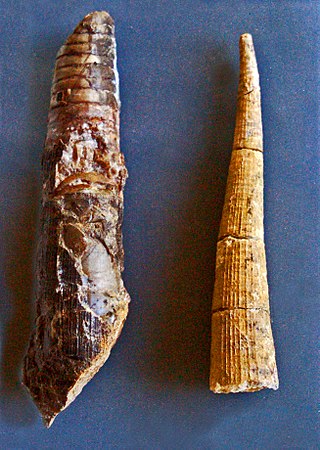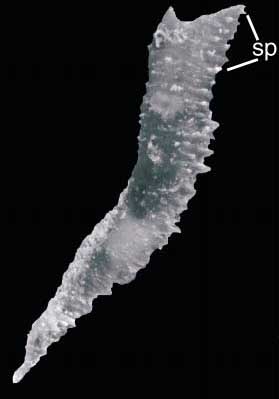
The Silurian is a geologic period and system spanning 24.6 million years from the end of the Ordovician Period, at 443.8 million years ago (Mya), to the beginning of the Devonian Period, 419.2 Mya. The Silurian is the shortest period of the Paleozoic Era. As with other geologic periods, the rock beds that define the period's start and end are well identified, but the exact dates are uncertain by a few million years. The base of the Silurian is set at a series of major Ordovician–Silurian extinction events when up to 60% of marine genera were wiped out.

Tentaculites is an extinct genus of conical fossils of uncertain affinity, class Tentaculita, although it is not the only member of the class. It is known from Lower Ordovician to Upper Devonian deposits both as calcitic shells with a brachiopod-like microstructure and carbonaceous 'linings'. The "tentaculites" are also referred to as the styliolinids.

Tabulata, commonly known as tabulate corals, are an order of extinct forms of coral. They are almost always colonial, forming colonies of individual hexagonal cells known as corallites defined by a skeleton of calcite, similar in appearance to a honeycomb. Adjacent cells are joined by small pores. Their distinguishing feature is their well-developed horizontal internal partitions (tabulae) within each cell, but reduced or absent vertical internal partitions. They are usually smaller than rugose corals, but vary considerably in shape, from flat to conical to spherical.

Stromatoporoidea is an extinct clade of sea sponges common in the fossil record from the Middle Ordovician to the Late Devonian. They were especially abundant and important reef-formers in the Silurian and most of the Devonian. The group was previously thought to be related to the corals and placed in the phylum Cnidaria. They are now classified in the phylum Porifera, specifically as a type of sclerosponges. There are numerous fossil forms with spherical, branching or encrusting skeletons of laminated calcite.

The Burgsvik Beds are a sequence of shallow marine limestones and sandstones found near the locality of Burgsvik in the southern part of Gotland, Sweden. The beds were deposited in the Upper Silurian period, around 420 million years ago, in warm, equatorial waters frequently ravaged by storms, in front of an advancing shoreline. The Burgsvik Formation comprises two members, the Burgsvik Sandstone and the Burgsvik Oolite.
The Mulde event was an anoxic event, and marked the second of three relatively minor mass extinctions during the Silurian period. It coincided with a global drop in sea level, and is closely followed by an excursion in geochemical isotopes. Its onset is synchronous with the deposition of the Fröel Formation in Gotland. Perceived extinction in the conodont fauna, however, likely represent a change in the depositional environment of sedimentary sequences rather than a genuine biological extinction.
Graticula, formerly incorrectly named Craticula, is a genus of Palaeozoic coralline alga. They form the framework of reef rocks in the Silurian of Gotland, from the Högklint, Slite and Halla groups.

Cornulitida is an extinct order of encrusting animals from class Tentaculita, which were common around the globe in the Ordovician to Devonian oceans, and survived until the Carboniferous.
Cobcrephora is a genus of that resembles the Palaeoloricates, known from the Silurian of Gotland. Its interpretation as a polyplacophoran is widely challenged.

Kionoceras is an extinct nautiloid cephalopod genus included in the orthocerid family Kionoceratidae with scattered worldwide distribution from the Middle Ordovician to the Lower Permian. Kionoceratids are orthocerids with prominent longitudinal ornamentation on their shells, sometimes augmented by secondary transverse ornamentation. Orthocerids are, of course, prehistoric nautiloides with generally straight and elongate shells, mostly with central or subcentral siphuncles.

Pilina unguis is an extinct species of Paleozoic Silurian monoplacophoran. It was first named as Tryblidium unguis and described by Gustaf Lindström in Latin from the Silurian deposits of Gotland in Sweden, in 1880.
Rothpletzella is a genus of calcimicrobe known from the Silurian of Gotland, the Devonian of France, as well as the Ordovician of China. It has been hypothesised to be a cyanobacterium, and shares morphological similarities with extant cyanobacteria. The genus is named in honor of August Rothpletz.

Anticalyptraea is a fossil genus of encrusting tentaculitoid tubeworms from the Silurian to Devonian of Europe and North America . Anticalyptraea commonly encrust various invertebrate fossils such as stromatoporoids, rugose corals, bryozoans, brachiopods and crinoids, but they can also be common on the hardgrounds.

Cornulites is a genus of cornulitid tubeworms. Their shells have vesicular wall structure, and are both externally and internally annulated. They usually occur as encrusters on various shelly fossils. Their fossils are known from the Middle Ordovician to the Carboniferous.

Conchicolites is a fossil genus of cornulitid tubeworms. Their shells lack vesicular wall structure and have a smooth lumen. They are externally covered with transverse ridges. Some species have spines. They usually occur as encrusters on various shelly fossils. Their fossils are known from the Late Ordovician to the Devonian.

Coralloconchus is a genus of cornulitid tubeworms with small, slender, irregularly curved conical tubes with slowly increasing diameter. Tubes have thin walls and a smooth lumen. Tube wall has a lamellar microstructure. Tubes are devoid of septa and vesicles in the adult part and are not spirally coiled.
Ozarkodina is an extinct genus of conodonts in the family Spathognathodontidae.

Hamra is a populated area, a socken, on the Swedish island of Gotland. It comprises the same area as the administrative Hamra District, established on 1 January 2016.

Odontopleura is a genus of spinose odontopleurid trilobite in the family Odontopleuridae, and is the type genus of that family and of Odontopleurida. The various species are found in Upper Ordovician to Middle Devonian marine strata throughout the world. The best studied fossils are of the type species, O. ovata, from the Wenlock-aged Liteň Formation in Loděnice, in Bohemia, Czech Republic, and, southeastern Gotland, of Sweden.
Dudleyaspis is an extinct genus of Lower to Middle Devonian odontopleurid trilobites that lived in a shallow sea that lay between Euramerica and Gondwana. It was named in 1949 by Prantl & Pribyl.















